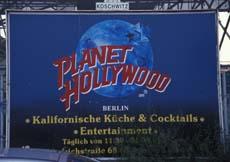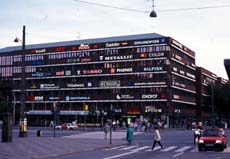index
Totalizing criticisms
click on images for full-size:




Planet Hollywood, a themed restaurant chain whose name suggests what the commodification critique fears has happened

A building on the city square in Copenhagen, decorated with the logos of multi-national corporations

Sold, sold, sold
Some features of today's places that look negative, such as discontinuity and fragmentation, show new kinds of linkage and unity that can be developed positively. Many critics would dismiss this claim as superficial or even dangerous. They would say that whatever the grammar of places might be, the whole act of human dwelling has been thinned out. My suggestions about linkages and new kinds of unity then either sell out to the enemy or offer cliches when deep therapy is needed. With obligatory reference to Disney and tourism, places today are said to have become thin commodified simulacra of their former selves. "Commodification" and similar evaluative concepts can be used as diagnostic tools, but they are too often used as totalizing Essences for the entire being of today's places. They fit into the anti-narrative narratives circulating today about global capital, or the media, or other unstoppable forces. The processes of modernization, global capitalism, and the media are all too real and profoundly affect places today, but that does not prove total domination or total changes in the being of place. Widespread trends are not irresistible universal forces. The question is how those trends influence concrete places. It is true that global markets and the mass media cannot be avoided in today's world; their systematic effects are everywhere -- forced connections and shifting allocation of resources, with consequent restrictions or expansions of the available courses of action. These effects, though, do not decide their own meaning or their impact on the norms and grammars of places. Meaning and norms get their force through communal reinterpretation, which is an active rather than a passive reception.